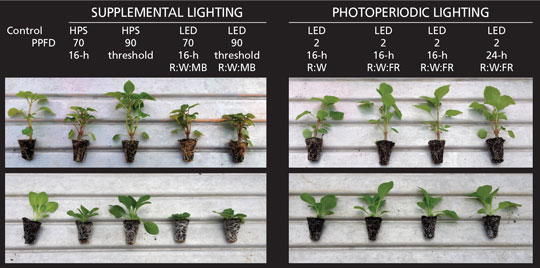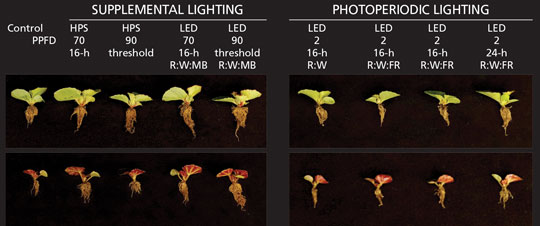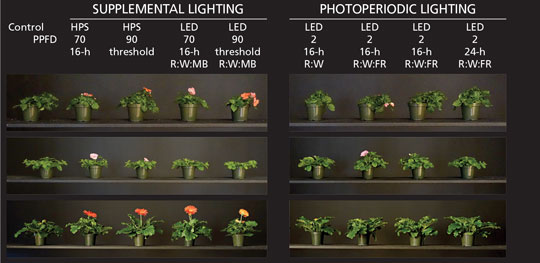10/1/2017
Producing High-Quality Plugs
Allison Hurt & Roberto Lopez
Part 2 of a four-part series on manipulating light quality, quantity and duration during greenhouse plug production.
In the first article of our four-part series, we outlined the materials and methods we used in our supplemental and photoperiodic lighting of bedding plant plug study. In this article, we’ll share our findings and recommendations.
Supplemental lighting of plugs
For petunia, gerbera and impatiens, we found that plugs grown under continuous 16-hour or threshold LED supplemental lighting for four weeks were more compact (reduced stem length and leaf area) than plugs grown under continuous 16-hour or threshold HPS supplemental lighting (Figure 1). Compared to the control, root dry mass of all species was higher under all supplemental lighting treatments and wasn’t influenced by supplemental light intensity or duration, with the exception of impatiens—which was greatest under threshold HPS supplemental lighting.
 Figure 1. Impatiens (top) and petunia (bottom) plugs after four weeks under no electric lighting (control), supplemental or photoperiodic lighting.
Figure 1. Impatiens (top) and petunia (bottom) plugs after four weeks under no electric lighting (control), supplemental or photoperiodic lighting.
Stem diameter, shoot dry mass and leaf number were higher for petunia and impatiens plugs grown under threshold HPS lighting providing 90 µmol•m−2•s−1 compared to the other supplemental lighting treatments. This difference can be partially attributed to an increase in plant temperature under HPS lamps. Tuberous and wax begonia were equally as compact under HPS and LED supplemental lighting. However, tuberous begonia grown under 90 µmol•m−2•s−1 of threshold supplemental lighting from LEDs had the greatest root and shoot dry mass (Figure 2).
 Figure 2. Wax and tuberous begonia plugs after six weeks under no electric lighting (control), supplemental or photoperiodic lighting.
Figure 2. Wax and tuberous begonia plugs after six weeks under no electric lighting (control), supplemental or photoperiodic lighting.
The overall quality of the plugs (quality index) was calculated by using the following equation: [total dry mass (root mass:shoot mass ratio + stem diameter/stem length)]. For all species, the quality index was two to four times higher under LED and HPS supplemental lighting than under no electric lighting. Only the quality index of tuberous begonia was reduced under threshold HPS lighting due to a reduction in root dry mass.
Photoperiodic lighting of plugs
The most compact petunia and gerbera plugs in the photoperiodic lighting study were those grown under no electric lighting or LEDs providing DR:W light for 16 hours (Figures 1 and 2). Low-intensity LEDs providing far-red light promoted stem elongation and larger leaves when they were run for 16 or 24 hours.
Impatiens were most compact (reduced stem elongation and leaf area) under LEDs providing R:W:FR light for 24 hours (Figure 1). Stem diameter and shoot dry mass of tuberous begonia were reduced under LEDs providing R:W:FR light for 24 hours compared to the control. The quality index for all species was the same regardless of photoperiodic lighting treatment. However, the quality index of plugs grown under photoperiodic lighting was significantly lower than plugs produced under supplemental lighting.
Subsequent flowering
While there were some differences in flowering time between plugs propagated under supplemental or photoperiodic lighting, the overall appearance of the plants was very similar at flower (Figure 3). Plant height of gerbera and petunia wasn’t different at first open flower for any of the treatments. However, impatiens grown under photoperiodic lighting as plugs were slightly taller at flower than those under supplemental lighting, but not enough to impact quality.
 Figure 3. Flowering responses of impatiens (top), petunia (middle) and gerbera (bottom) plugs grown under no electric lighting (control), supplemental or photoperiodic lighting, transplanted into 4- or 4.5-in. containers and finished in a common greenhouse environment.
Figure 3. Flowering responses of impatiens (top), petunia (middle) and gerbera (bottom) plugs grown under no electric lighting (control), supplemental or photoperiodic lighting, transplanted into 4- or 4.5-in. containers and finished in a common greenhouse environment.
Plugs under supplemental lighting generally flowered faster than those under photoperiodic or no electric lighting. Time to flower of petunia under no electric lighting, LED supplemental lighting and photoperiodic lighting providing R:W light was delayed compared to plants under HPS supplemental lighting and photoperiodic lighting providing R:W:FR light. This can be attributed to lack of far-red light under these supplemental and photoperiodic lighting treatments.
Overview of what we found
Under low ambient DLIs (5 to 7 mol•m−2•d−1; Table 1 in article 1), production time of plugs grown under supplemental lighting was reduced by one to two weeks, depending on the species, and plugs were of higher quality (i.e., increased stem diameter, root and shoot dry mass, and quality index) than those grown under no electric or photoperiodic lighting. Stem elongation and leaf area of petunia, gerbera and impatiens grown under LED supplemental lighting was reduced compared to plugs under HPS lamp supplemental lighting or no electric lighting.
These quality parameters were generally not influenced by the light intensity or hours of operation (threshold or continuous supplemental lighting; Table 1 in article 1) or light quality or duration (photoperiodic lighting). Plugs grown under photoperiodic lighting visually appeared larger, due to larger leaves and increased stem elongation, compared to plugs grown under no electric light lighting. However, root development was delayed compared to plugs grown under supplemental
lighting.
Based on the results of this study, our recommendation for growers is to utilize threshold HPS or LED supplemental lighting providing 70 to 90 µmol•m−2•s−1 for energy savings. The decision between HPS or LED fixtures is dependent on several factors including: fixture and installation costs, efficacy, spectrum, longevity, shading, method of cooling, maintenance and greenhouse electrical costs and capacity, available rebates, and yearly hours of operation.
Supplemental lighting will allow propagators that produce and ship large quantities of plugs to increase crop turns, uniformity and overall quality. For those operations unable to invest in supplemental lighting and can wait an additional week or two for their plugs to become marketable, photoperiodic lighting may be sufficient.
GT
Allison Hurt is an M.S. student and Roberto G. Lopez is an Assistant Professor and Controlled Environment/Floriculture Extension Specialist in the Department of Horticulture at Michigan State University. The authors gratefully acknowledge Ball Horticultural Company and Syngenta Flowers for providing seed, C. Raker and Sons for seed sowing, Philips Lighting, HortAmericas, The Western Michigan Greenhouse Association, and The Metro Detroit Flower Growers’ Association for funding, and Nathan DuRussel for greenhouse assistance.